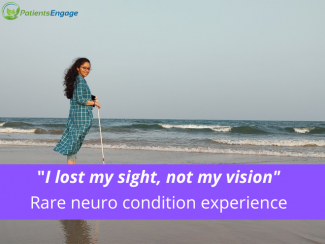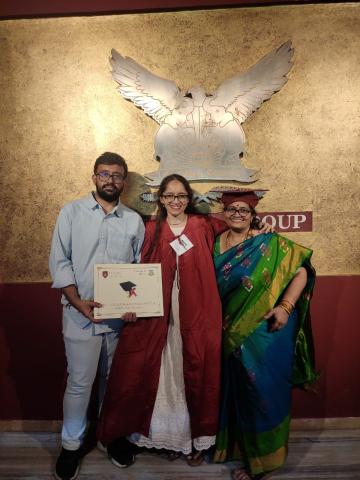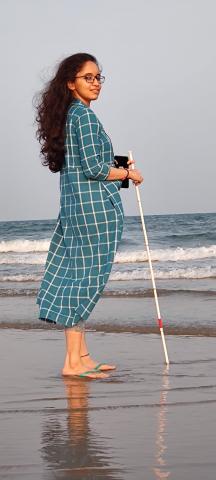
Kavya Poornima Balajepalli lost her eyesight at 21 after a brief period of intense headaches due to Idiopathic Intracranial Hypertension (IIH), a rare neurological disorder. Here she talks about her struggles after loss of vision, how she manages her condition and how she became an IIH warrior to create awareness about the disease.
Please could you tell us a bit about your background.
I am based in Visakhapatnam, Andhra Pradesh. I did my graduation in architecture from the University of Mumbai.
When were you diagnosed with Idiopathic Intracranial Hypertension (IIH)? At what age?
It was in August 2017, I was 21 years old.
One of the most common symptoms in IIH is headaches, or intense migraines. Did you also face similar symptoms initially? What was the frequency of your headaches? How did you manage them?
Headaches started in the first week of August. Migraine headaches mostly come in one part of the head. Pressure headaches are different. Head feels heavy and full, headaches are excruciating and throbbing in nature, and won't respond with pain killers.
In my case, I have PCOS (polycystic ovary syndrome), menorrhagia (heavy or prolonged periods) lasting for months and low haemoglobin, and my headaches were initially attributed to that.
The other common symptom, besides headaches, is blurred vision. When did that start and what was your reaction?
In my case it was double vision or diplopia which started in the beginning of the second week of August but during this stage I could barely open my eyes due to severe headaches. Blurred vision could also be there. But whenever I opened my eyes, vision was slightly more blurred, I couldn’t differentiate much as I was myopic. One important observation was my refractive eye correction powers increased more frequently, that is twice in the last six months. It normally changes once in a year or two.
Other symptoms apart from headaches were extreme fatigue, chronic back pain especially near shoulder blades, hyperacusis (increased sensitivity to sound), nausea, photophobia, and brain fog (cognitive fog) among some others. General physicians attributed all this to low haemoglobin and general illness. All these symptoms started around ten days before my vision loss and didn’t improve with conservative treatment.
Could you tell us a little bit about your loss of vision loss? Did it happen suddenly? What was the medical cause explained?
My loss of vision was very sudden. I could see very well till 11th August night except for slight blurred vision in my right eye and some double vision.
Unfortunately, my periods started the same day in the midst of all my IIH symptoms. This sidetracked the issue about my headaches. My last periods had continued for 60 days and now, barely a fortnight later, a fresh menstrual cycle had begun. As I was already anaemic, I think the focus and priority at this stage was on controlling any further loss of blood as I was extremely weak. I was admitted in a Gynaecological Hospital and doctor administered injection of tranexamic acid (used to control or prevent excessive or heavy bleeding) and some painkillers for backache and headache.
Next morning, my mother tried to wake me up as it was late. When I opened my eyes, everything was dark. I was a little upset with her. ‘Why are you waking me up so early when it is still night,’ I grunted. My mother looked puzzled and said that it was not night, but late morning. I opened my eyes wide again, rubbed them with both my hands but couldn’t see anything. I told my mother I couldn’t see anything at all. My mother got worried and called the doctor immediately. I was rushed from the gynaec centre, to an eye hospital. On preliminary examination the ophthalmologist said I had malignant papilledema (optic disc swelling) and referred me to another hospital with a speciality in neurology.
It is not uncommon to misdiagnose a patient with IIH. Did you face any difficulties? What tests were done?
The neurologists initially felt it was a case of cerebral venous thrombosis (blood clot of a cerebral vein) and the spectrum of related conditions. Then they thought it could be a spectrum of optic neuropathies and also evaluated for neuromyelitis optica.
The doctors did a lumbar puncture on 13th August 2017 and understood the intracranial pressure was very high (around 55 while the normal pressure is below 15)
After re-evaluating other causes with help of contrast MRIs and other tests, they finalised the idiopathic intracranial hypertension or benign intracranial hypertension on 14th August 2017. We were told that high pressures compressed my optic nerves which caused the vision loss.
They have put me on a fixed lumbar-drain to relieve the pressure.
What treatment did you have to undergo to manage your IIH?
While I was on a lumbar drain, they posted for optic nerve sheath fenestration surgery (ONSF). It was a lengthy procedure and I was kept under observation for two days to see if there will be any changes in my vision. I started to feel a slight perception of light in my right eye as I could blink my eyes but there was nothing promising. I could not move my eyeballs due to the restricted ocular movement. (My neuro ophthalmologist referred my condition as Fulminant IIH).

I was posted for VP shunt (Ventriculoperitoneal Shunt) surgery on but at the last moment the neurosurgeon took the call to proceed with LP shunt as my ventricles were very narrow.
After the LP shunt (LumboPeritoneal Shunt), I could see some hand movements close to my right eye but no perception of light in my left eye. I have developed low pressure headaches or spinal headaches after LP shunt and slowly recovered with high fluid intake and caffeine. I was also prescribed corticosteroids over a period of two months. My headaches subsided and I have regained a tiny patch of vision in my right eye which would merely capture static things and not moving objects.
Until now apart from a few revisions, I am doing better but no improvement in vision except 2% of visual field in right eye and 0% in left eye. Usage of corticosteroids during treatment caused steroid induced osteoporosis for which I took separate treatment.

You also had to undergo many surgeries. What were these surgeries for?
Optic nerve sheath fenestration surgery to decompress the optic nerves and LP shunt or VP shunt was to regulate (drain) my intracranial pressure and to preserve the small island vision in my right eye.
How did your family members help in managing your illness?
My family is very understanding, especially my brother who supported me throughout by learning everything about IIH and other comorbidities, patiently answering my mother's questions, and sharing every small detail of the process I was going through. This helped me to understand my condition the best possible way. They were always willing to try any treatment and go to any extent if there is anything which helps me.
The loss of vision due to your illness must have altered your life completely. How did you face the challenges after that?
I lost my vision when I was in my final year (fifth year) of B. Architecture and many people including my college faculty asked me to choose a different profession as it was not possible to pursue architecture without vision.
After the VP shunt I waited for a year and then decided to resume back. We gave representations to the university and got special approvals. I have completed my graduation in 2021 with the help and support of my friends and a few gifted mentors in college.
Family members used to feel bad about my vision loss and worried about my future. Out of pain and concern, they even used to speak discouragingly about the future. I somehow gave them confidence that it was just the eyesight which I lost, not vision!

Have you had any issues with your Body Mass Index (BMI) or blood pressure ever?
No, Never. I am quite moderately built, actually a bit underweight. I do not have high BP (blood pressure).
Also read: Suzanne's experience with IIH (Idiopathic Intracranial Hypertension)
What is your present condition? And what are you currently pursuing?
I am managing my IIH with a VP shunt, regular eye evaluations, and occasional pain management. Also, exploring the second phase of life adapting to the acquired visual disability. Currently, I am pursuing a Fellowship under NCPEDP (National Centre for Promotion of Employment for Disabled People) -Javed Abidi Fellowship on Disability where I am working on advocacy endeavours concerning Accessibility in Public Spaces (beaches of Visakhapatnam). I am utilising my skills and ideas, striving for inclusiveness in the society and promoting inclusive architecture. It is a Delhi based pan-India cross-disability disability organization.
I have also started an endeavour, called Poornamidam, to take cognizance of issues concerning Disability, Universal Accessibility, and Inclusive Architecture and raise awareness through data-driven and evidence-based research and advocacy to bring change.
IIH Warrior India is another initiative to support the co warriors in India to share everything about IIH.
In the course of your illness, you have also become an ‘IIH warrior’ creating awareness and helping people manage the disease. What is your advice to patients facing similar situations?
- Be adaptable and resilient to change.
- Never be scared. Start learning about your condition, you can only control the controllable. The more you understand, the better you can handle it.
- Stop comparing yourself with anything and everything. Everyone's experiences are unique in their own way. There is no exact definition for being normal, so just don’t compare.
- Prioritise your health. Maintain a healthy Body mass index (BMI), monitor your pressures (especially eye and cranial when experiencing headaches) and keep following doctor’s advice.
- Also, love your eyes, get the vision evaluated regularly, and don’t ignore headaches and any other such invisible symptoms that might even appear not so serious.
- Understand the science behind the condition. Share what you know with others and if possible help in preventing others from going through this or help them manage the invisible illness in a better way. Please remember, you are not alone.







